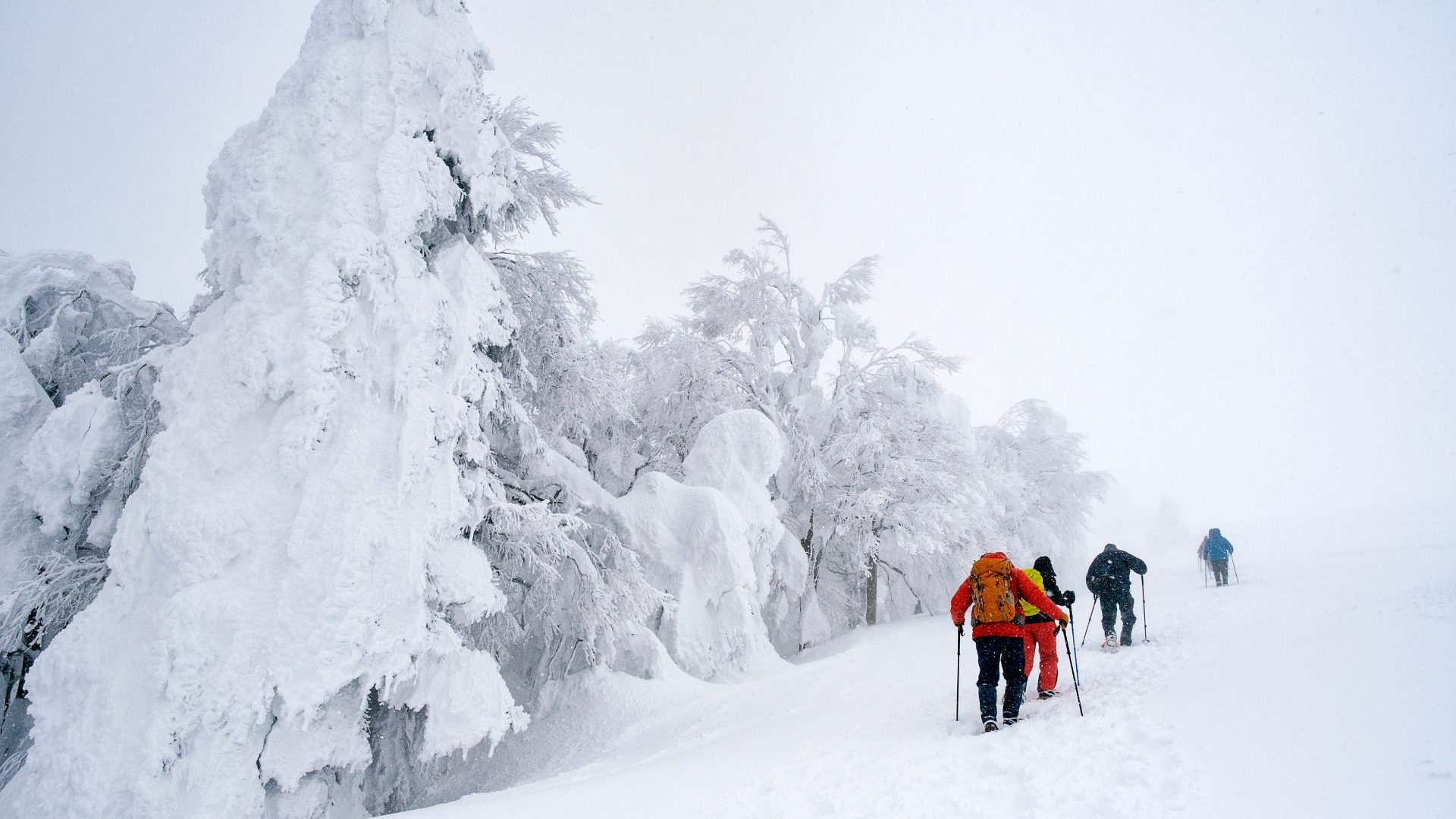
Japan’s ski slopes are world-famous for good reason. But there’s another way to explore the Japanese winter countryside… and that’s on snowshoes. Writer Lynn Gail takes a walking tour of an entirely different kind in Tohoku.

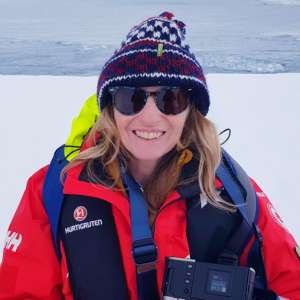
Japan’s ski slopes are world-famous for good reason. But there’s another way to explore the Japanese winter countryside… and that’s on snowshoes. Writer Lynn Gail takes a walking tour of an entirely different kind in Tohoku.
I’m focused on one thing: Staying upright. My shiny, one-size-fits-all, snap-on snowshoes are the size of a small skateboard, but I’m not feeling the cool-kid vibe. It’s more a prehistoric, dinosauric moonwalk as I attempt to move forward.
“Keep your legs parallel like you’re horse riding,” explains our guide, Tetsuo Sato. “Put your heel down first, then slide your feet through the snow.”
Silently repeating “heal, slide, heal, slide,” the snowshoe shuffle starts to click as I crunch my way through crisp virgin snow up Mt Iide, an almost 7,000-foot (2,105 meter) peak, in the Tohoku region of Japan’s Honshu Island.
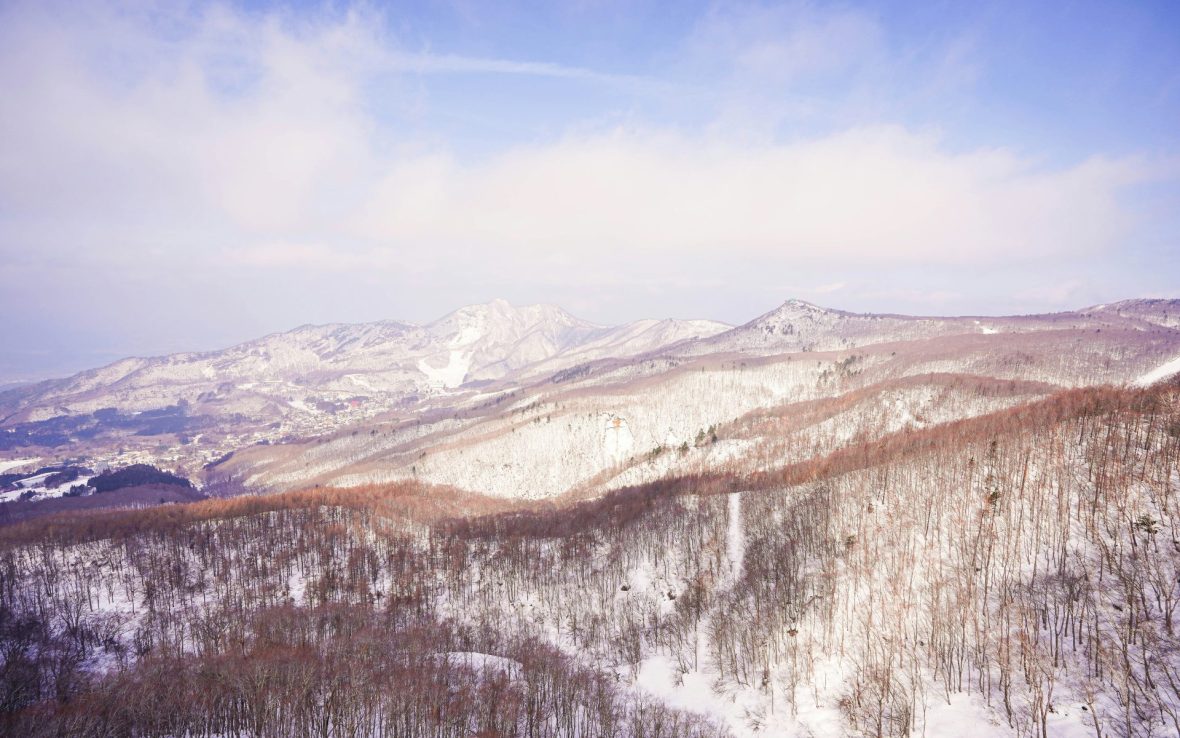
Located in the northern Yamagata Prefecture, Tohoku used to be known as Japan’s ‘black-sheep’ region. Remote, rugged, and run by outlaws who resisted rule, the area was not accepted into the Japanese nation-state until the 12th century.
Polar winters from December to March further isolated the area, cutting it off from neighboring regions. Modern roads and bridges now make the area easy to reach by car from Yonezawa Station, a short Shinkansen (bullet train) ride from Japan’s capital city, Tokyo.
Standing knee-deep in snow it’s hard to imagine this silent wonderland was once home to a lawless, ‘wild west’ society. The valley stretches around us, a cape of soft crested peaks dusted in snowflakes. Rice paddies lay hidden under a duvet of thick snowfall, distant villages peak out from the winter, and, besides our group of seven snowshoers, there’s not a soul in sight.
It takes a studied level of Zen mindfulness to walk, totally naked, through icy snow and I skid and stumble en route. Making it to the bath, I sink blissfully into steaming water.
Unlike skiing, anyone with a good base fitness can snowshoe with little training, as is proven by a sprightly 77-year-old gentleman on our tour who has no problems keeping up.
We hike past cedar trees with branches bending under snow, pause at a one-kilometer signpost certain we’ve hiked further, and continue to the summit where Tetsuo shovels out a snow bench and treats us to hot tea, coffee and okaki (dried plum).
“It’s much easier going down,” says Tetsuo with a wink. On the descent, he digs a ‘slide’ through a two-meter-high snowdrift. A slight push sees me flying down the snow-fantastic quietude—a middle-aged woman abandoning all restraint. At the bottom, we watch dusk flicker over fresh snow until it’s time to get acquainted with Japan’s oldest tradition—onsen bathing.
Japanese people have been bathing in natural hot spring baths (onsen) since it became popular in the Edo period (1603-1867). Over 100 active volcanoes throughout Japan produce geothermally heated water, which have naturally created some 27,000 onsen. Bathroom facilities rarely exist in rural homes and inns; instead, it’s custom to bathe and gossip daily at the community onsen.
Tetsuo explains the rules. “It’s hadaka no tsukiai, naked communal bathing,” he says. “More importantly, check the sign: Onna-no-yu for women, the red curtain, and otoku-no-yu is for men, and blue.” He also tells us the yukata (kimono) should be worn left side over the right (the other way is for funerals).
Keen to thaw out, I shuffle to the red curtain in slippers two sizes too big and drop my inhibitions at the door. There’s no privacy here. A line of shower heads hang on the wall like old dial-up telephone receivers. I clean myself from head-to-toe, as is the correct etiquette, before heading to the outside onsen.
It takes a studied level of Zen mindfulness to walk, totally naked, through icy snow and I skid and stumble en route. Making it to the bath, I sink blissfully into steaming water. It’s just me. Moonlight illuminates sleet falling across my face as I bathe in the hot mineral water, full of sulphate, sodium, potassium and magnesium, known to soothe the body and slow the mind.
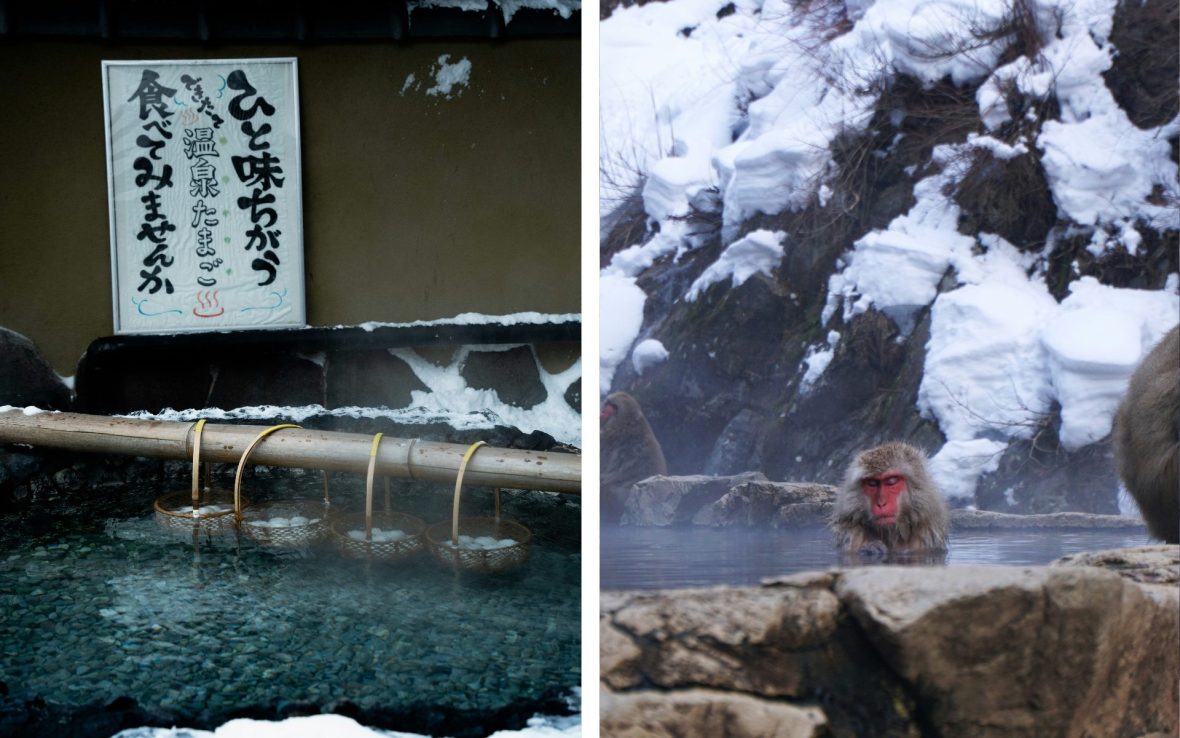
“A snowstorm is approaching,” warns Tetsuo the following morning. “It’s the season’s worst, and we may not see juhyo”.
The Juhyo snow monsters are a remarkable, rare phenomenon found only in the subalpine regions of North Tohoku. An accumulation of ice and snow brought on by harsh Siberian winds blanket Mt Zao’s Maries’ fir trees once a year, transforming the mountain forest into thousands of misshapen creatures. But these creatures are a temperamental bunch. To see them, the weather must remain between five and 14 degrees Fahrenheit (-15 to -10 degrees Celsius); too warm and the creatures melt.
Desperate to witness the juhyo, I recklessly push on, but the imminent blizzard bashes my face with freezing sleet. The mountain turns into a whiteboard.
With a prayer to the weather gods, we board the first of two ropeway cable-cars meant to get us to the top of the 5,700-foot (1,736 meter) peak. But the wind is too strong for the second car to operate. So from the 2,800-foot mark, it’s snowshoe time.
“First, we attach kanjiki—traditional snowshoes,” says Sato, a spry albeit weathered 74-year-old mountain guide. Originally used for hunting during bitter winters, kanjiki are made of wood twisted into a ring, with thick rope that attaches to the boot. “Emergency rescue teams still use them to move quicker in deep snow,” he says, as if to convince us of their functionality. “They’ll stop you from sinking!”
It’s five degrees Fahrenheit. Heat packs inside my gloves and boots stave off numbness. Apart from the trickiness of tying the kanjiki rope, the simple design proves easier to walk in—they’re lighter and less bulky than modern snowshoes.
We plough steeply upwards until we finally see them—the hulking mythical monsters loom ahead. Just as we’re about to reach the army, an oncoming wind picks up speed. Desperate to witness the juhyo, I recklessly push on, but the imminent blizzard bashes my face with freezing sleet. The mountain turns into a whiteboard. “We need to turn back,” shouts Sato. “It’s not safe!” Drenched, we trudge down, a group of roving snow monsters with frozen hair.
In the afternoon, after a homely family-style lunch of tempura, panfried fish and potato soup, we swap snowshoes for spiked ice cleats, strapped to the soles of our shoes to climb the thousand steps to the Risshakuji Buddhist Temple.
Built on the slopes of Mount Hoju in the eighth century, the temple complex is known for being the inspiration for one of Japan’s greatest poets—Matsuo Basho. It was here, in 1689, that he composed his most famous haiku:
shizukasa ya
iwa ni shimiiru
semi no koe
Ah, this silence
Sinking into the rocks
Voice of cicada
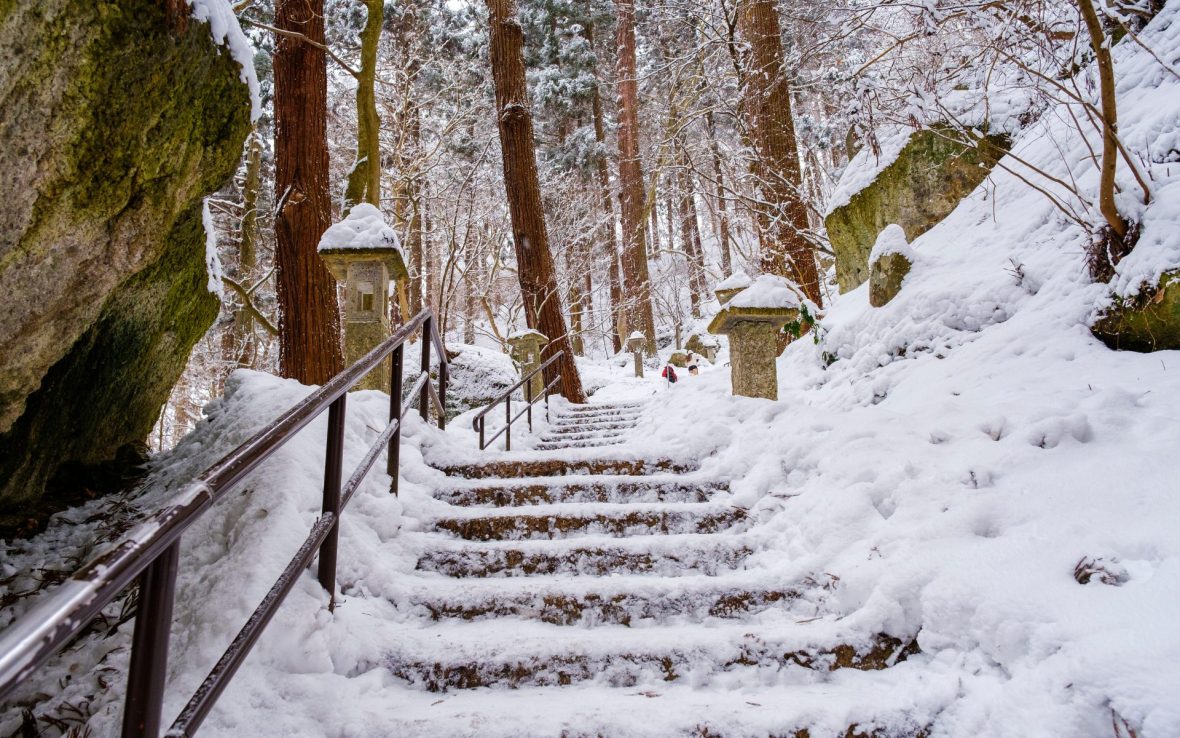
It is said that each step gives you the opportunity to let go of what you don’t need. As I climb the winding path, I let myself brush away unwanted baggage. I tip my hat to Mother Nature for brushing the world white. It’s silent as I focus on the icy stairway, but far too cold to hear cicadas.
At the top I make an offering. I pray Tohoku’s untouched region retains its last-frontier charm, that its vast wilderness remains protected, and that, as tonight’s steaming onsen beckons, the source of the nation’s most pampering pastime keeps bubbling away, naturally heated by the heart of Japan.
The writer was a guest of Walk Japan’s Tohoku Hot Spring Snow Tour
****
Adventure.com strives to be a low-emissions travel publication. We are powered by, but editorially independent of, Intrepid Travel, the world’s largest travel B Corp, who help ensure Adventure.com maintains high standards of sustainability in our work and activities. You can visit our sustainability page or read our Contributor Impact Guidelines for more information.

Lynn Gail is an award-winning travel writer and photographer based along the coast in Western Australia. Travel feet since birth, she specializes in culturally diverse subjects, regularly writing and photographing for a range of Australian and international titles, including National Geographic Traveller Uk and Australian Geographic. Ask her to spend time with intact tribes, she’ll be on the next bus. She also runs immersive small group photography tours.




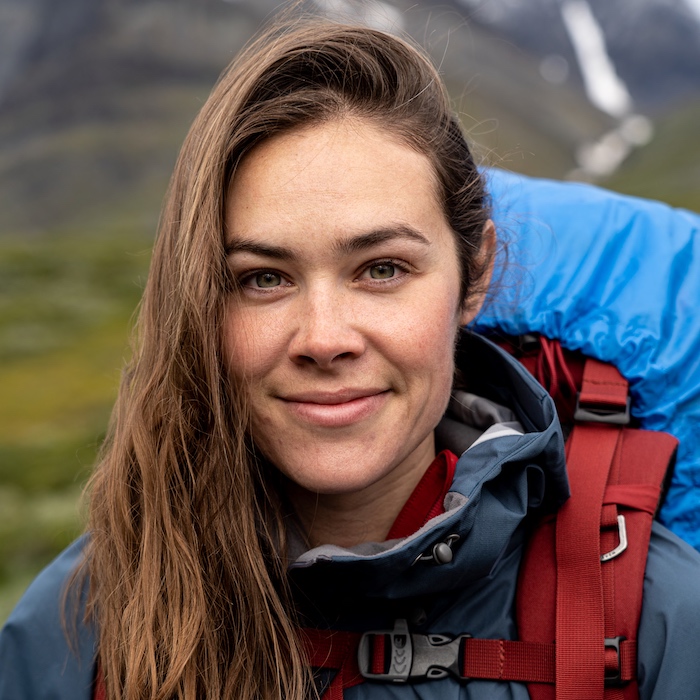



Can't find what you're looking for? Try using these tags: